
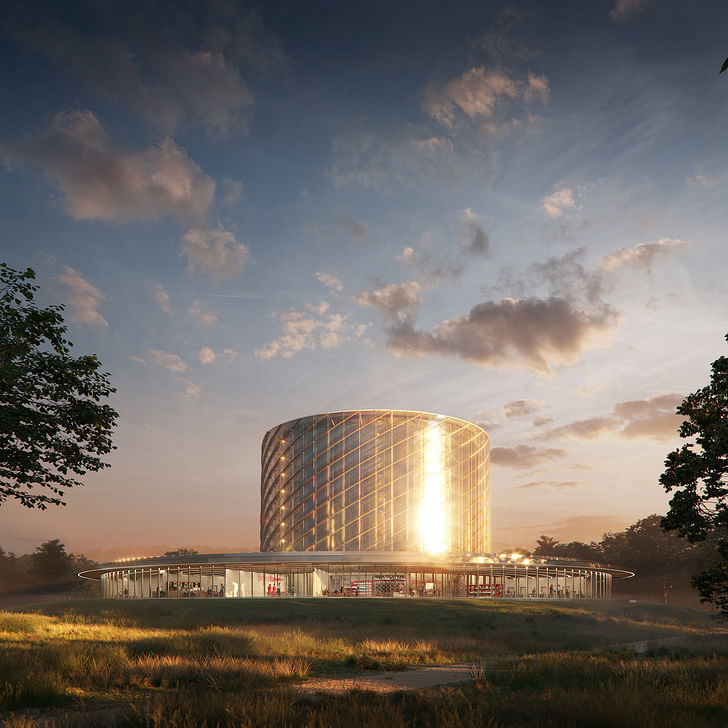
The architecture of energy systems is undergoing a renaissance. As our ability to generate, consume, and store energy in a clean, sustainable way continues to accelerate, spurred by a heightened awareness of climate change, architects are steadily sculpting a new architecture to celebrate, showcase, and interweave these new technologies into the built environment.
To explore this new architecture of energy infrastructure, we spoke with two prominent architecture firms, AL_A and C.F. Møller Architects, both of whom have recently overseen the design of energy schemes that prioritize transparency, interaction, and a contemporary architectural flare. In addition to exploring the design process of energy infrastructure, we reflect on future possibilities for the energy typology and the role that architecture studios large and small can play in shaping it.
In 2019, the U.S. Energy Information Administration (EIA) projected that by 2050, the world’s energy usage will have increased by 50%. The rise in demand, predominantly driven by accelerating urbanization in Asia, includes a 65% increase in energy consumed in buildings. With this rapid rise in energy demand, we can expect to see a significant expansion in the design and construction of infrastructure tasked with supplying this energy, from power plants to switch stations to energy storage facilities.
For architects, there is merit in reflecting on what this surge in demand for energy infrastructure will mean for cities. While one could be forgiven for placing the responsibility for delivering these projects exclusively on electrical engineering teams, architectural history is dotted with examples of architects engaging with the design of energy infrastructure, the results of which can reverberate for decades. In the case of Peter Behrens’ AEG turbine factory in Berlin, Germany, this infrastructure can become the trigger for an entire architectural movement. Behren's seminal factory, completed in 1909, is considered the first to apply classical stylistic elements to an industrial building, setting an important early modernist reference for Bauhaus pioneers Walter Gropius and Mies van der Rohe, both of whom worked under Behrens during the project. Technology giant Siemens still produces gas turbines in the building to this day, over one hundred years later.
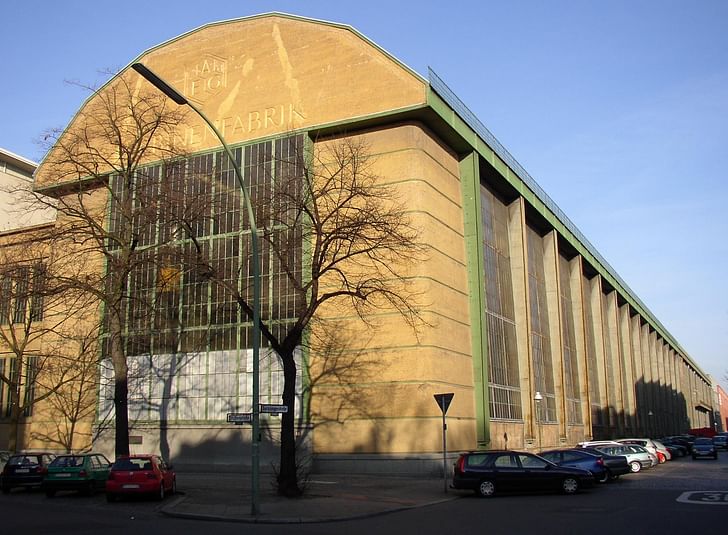
This longevity was further manifested later in the 20th century by British architect Sir Giles Gilbert Scott, designer of two prominent pieces of energy infrastructure which still play a prominent role in London’s urban fabric. 1955 saw the completion of Scott’s Battersea Power Station, notable as one of the world’s largest brick buildings, and for its Art Deco interior décor. Following its decommissioning in 1983, the entire station gained Grade II listed status in recognition of its architectural value and is today the subject of a planned $12 billion mixed-use development. Scott’s second scheme, the Bankside Power Station, was completed in 1963. Today, the building is better known as the Tate Modern. Having undergone a $180 million Herzog and de Meuron-led transformation between 1995 and 2000, the former power station has now become one of the world’s largest art museums, and one of London’s preeminent architectural gems. As an intriguing side-note, Scott was also responsible for the design of another staple of London’s urban fabric: the red telephone box.
Architectural history is dotted with examples of architects engaging with energy infrastructure, the results of which can reverberate for decades.
As 20th-century modernist relics from architects such as Behrens and Scott continue to exert influence over their respective cities, 21st-century energy infrastructure is undergoing a renaissance. Driven by a heightened awareness of climate change, new methods of energy production, storage, and recovery have brought with them a new architectural typology. In a departure from the imposing, opaque, and often distant energy architecture of the 20th century, this new movement is driven by ideas of transparency, interaction, and contemporary architectural flare.

For AL_A, this movement involves instilling the optimism and marvel of modern energy production in a built form. In August 2021, the firm unveiled plans for a prototype power plant in Oxfordshire, England, which is set to become the world’s first magnetized fusion facility when it opens in 2025. Unlike traditional fission stations, which generate energy through the splitting of atoms, fusion involves the merging of two atoms to generate vast amounts of energy, without the highly radioactive waste associated with nuclear fission. For Maximiliano Arrocet, a Director at AL_A, this process directly informed the design of the facility. “Fusion is the process that powers the sun and the stars,” Arrocet told Archinect. “So, in a sense, we are putting the sun in a box. The architecture of this space needs to capture the technological optimism of fusion to solve the energy problems of the world.”
The architecture of this space needs to capture the technological optimism of fusion to solve the energy problems of the world.
The clean aesthetic of AL_A’s scheme is grounded in a concentric form, with a central machine surrounded by a radial arrangement of support systems, all of which are equidistant from the core. By basing the scheme’s form on its technological efficiency, the design team argues that the power station can more easily adapt to future scientific developments and demands without undermining the scheme’s original vision. “We have adopted the concentric logic as the prime design principle; however it's not merely form following function,” Arrocet points out. “The other aesthetic driver here is transparency. This is a safe, clean technology that will change energy generation as we know it. A big motivation for us was to showcase what's happening inside — the concentric plan draws you into the core, the heart of the facility.”

AL_A’s fusion facility belongs to a new generation of architect-led energy infrastructure which, unlike its 20th-century predecessors, places an emphasis on reaching outwards to their surrounding context. In AL_A’s case, this involved interacting with Oxfordshire’s picturesque rural landscape. “We wanted the building to set up a reciprocal relationship between science and nature,” explained Arrocet. “On entering the building, you have views of the technology and the landscape. We have embedded into the design critical sustainability strategies, including solar control and natural ventilation for the industrial facility as well as for the support building. And again, we make use of the concentric logic to find a balance between the aesthetics and pragmatism of their arrangement.”

For architecture studios without prior experience in energy infrastructure, arguably the most intimidating aspect of such a project is comprehending the underlying technology itself. Curious about how AL_A navigated the complex and somewhat unprecedented infrastructure of fusion facilities, we asked Arrocet how the team began the process of comprehending the design challenge that lay ahead. “The entire team has dedicated many months to understanding the science of fusion and the complexities of each component required to make it work,” Arrocet explained.
Like watchmakers, we have had to open up the machine and get to grips with how each component works.
“Like watchmakers, we have had to open up the machine and get to grips with how each component works and fits in with the next, in order to understand how the building fits within the wider picture. The building is a continuation of the machine, and hence it was fundamental to understand how the machine itself works.”
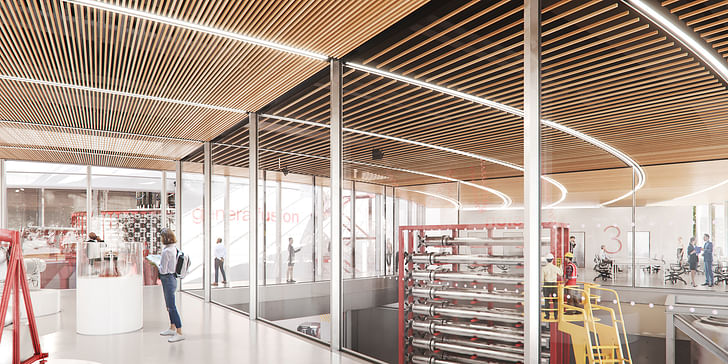
Unsurprisingly, AL_A’s scheme also involved the heavy input of external consultants, blending science, engineering, and architecture. For Arrocet, the range of consultants required for the scheme far outpaced that of more familiar architectural typologies, including the input of physicists and biodiversity experts. “Often, the building is the central focus of an architectural project, but here, it's just a portion of a much larger venture,” Arrocet explains. “Which is why we're thinking of the building as an extension, or another layer to the endeavor. It has been fascinating to align everyone on the vision for this project.”
C.F. Møller’s energy center offers an insight into the potential of district-level energy infrastructure to integrate directly into the dense urban fabric of major cities.
Fifty miles east of AL_A’s proposed facility, on London’s Greenwich Peninsula, sits another case study for the future of energy infrastructure in the form of C.F. Møller Architects’ Low Carbon Energy Center. While AL_A’s nuclear fusion plant is grounded in rural surroundings, dedicated to providing energy on a regional, even national level, C.F. Møller’s energy center at Greenwich offers an insight into the potential for district-level energy infrastructure to integrate directly into the dense urban fabric of major cities. The project, which was completed in 2016, is the largest new-build residential heat network in Europe, saving over 20,000 tons of carbon every year. Moreover, the scheme’s architecture, defined by a sculptural façade encasing the building’s 49-meter-high chimneys, has become a landmark in its own right, setting a contemporary benchmark for the ongoing redevelopment of the Greenwich Peninsula.

For Sam Whatman, architect at C.F. Møller and project lead for the energy center, the challenge for the scheme was less about the inner workings of the energy infrastructure but instead how to use a traditionally scorned typology as a catalyst for effective placemaking. “Today, energy infrastructure of this type is much greener than its predecessors, but it still carries the baggage of older, more harmful technologies,” Whatman explains. “People are hesitant to live near them. Therefore, our approach was to depart from the typical visual approach to energy infrastructure and break the stigma. From the outset, we felt that the best approach was to create something simple and refined, but also sculptural in nature. While we took direction from the lattice work of Greenwich’s industrial past, we drew the greatest inspiration form artists such as Richard Serra and Antony Gormley, using overscaled elements that played on contrasts between horizontal and vertical, light and dark.”
Our approach was to depart from the typical visual approach to energy infrastructure and break the stigma.
The sculptural aspirations for the scheme were realized through a collaboration with British artist Conrad Shawcross, who encased the building’s flue towers in a façade composed of hundreds of triangular perforated panels. Titled “The Optic Cloak,” the cladding folds and flows across the surface of the tower forming complex geometric patterns that play with vanishing points and perspective, culminating in an uneven, sculpture surface. In order to facilitate the concept, C.F. Møller worked closely with the project’s structural and MEP engineers to adapt the traditional design of energy center flue towers, prioritizing a clustered approach which would more easily lend itself to artistic appropriation.
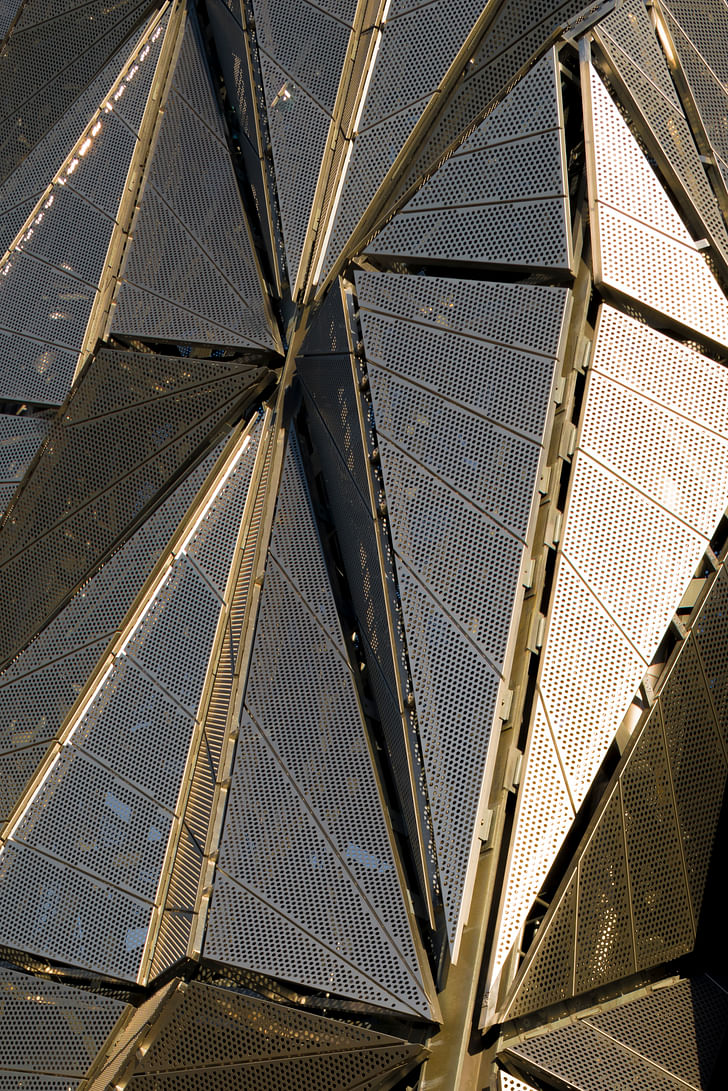
“Rather than have individual towers emerge from their respective machinery, we sought to collect the flues in a single band which allowed for a lean, distinct plate which Conrad’s team could appropriate,” said Rolf Nielsen, associate partner at C.F. Møller and a colleague of Whatman. “There was a significant level of architectural and engineering will behind how to create the conditions for a sculptural element. In particular, grouping the flues as a single linear band created a mass which was six times longer than it was wide, which resulted in extensive wind loading on one side. Our structural engineers, Price and Myers, were up to the challenge of reinforcing the mass appropriately.”
I see this typology as one that a young, small practice of three or four individuals could engage with.
One of the most intriguing insights into C.F. Møller’s experience at Greenwich was the size of the architectural team required to service the project. While one can be forgiven for assuming that the complexities of energy infrastructure would require an architectural studio to commit an outsized number of staff to the scheme, both Nielsen and Whatman believe the reality of the process is more accessible. “From a technical standpoint, this wasn’t a hugely challenging building in terms of the program,” Whatman says. “In contrast to a regular architect-led scheme, we were able to take the lead of the project’s MEP engineers and facilitate their spatial requirements. From an early stage, we were aware that the more flexibility we could design into the plan, the less impact any changes in machinery would affect the architecture. I see this typology as one that a young, small practice of three or four individuals could engage with and gain recognition from, if they capitalize on the potential for creating something sculptural and aesthetic.”
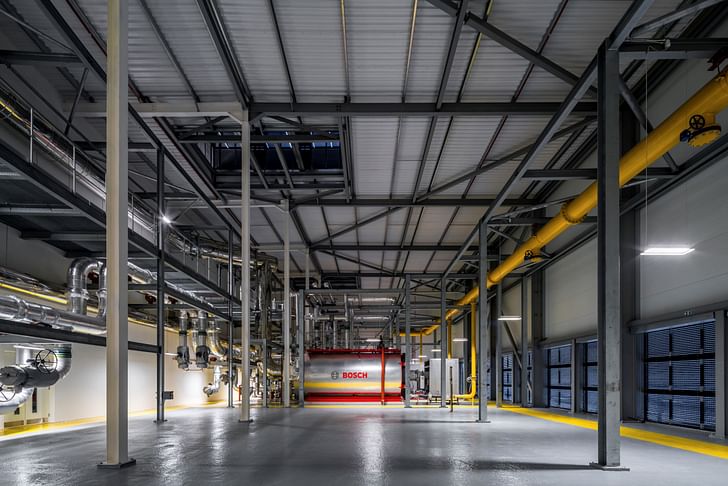
Whatman’s optimism for the ability of small practices to engage with energy infrastructure is echoed by Nielsen. “I believe that a small studio would be able to take on a project like this,” Nielsen says. “This is an approachable typology for a small office that has a passion for realizing a project with an aesthetic quality, particularly if they can merge an overall conceptual principle with a scalable use of materials and façade systems.” In a reflection that has resonance even beyond the energy typology, Nielsen also stresses the importance of allowing the design process to take its course. “This project was a different dynamic for us,” Nielsen explains. “We had to take the back seat and support the artist in realizing their creative dream, and make it work from a technical standpoint. In scenarios such as these, the design process can almost take on a life of its own. From the place where you start, the process can evolve, and new unexpected opportunities can arise. We must try to embrace those moments; they can be transformative.”

In a reflection on the future of energy infrastructure, the schemes by AL_A and C.F. Møller appear at first to be radically different, in terms of location, context, and the technology which they facilitate. However, the underlying ethos governing both schemes, that of breaking down the boundaries between energy infrastructure and the wider built environment, sends a clear message to the wider industry.
There is a widespread appetite for people to understand how energy is created, consumed, and distributed.
“Future energy typologies must place an emphasis on education and placemaking,” says Nielsen from C.F. Møller. “We must demonstrate how sustainable energy strategies can interweave with living and placemaking. We are moving towards a new era, one where landscapes are the hosts for energy infrastructure, rather than the raw material in the form of coal or gas. Landscapes, including urban ones, are increasingly being used for energy production, rather than energy extraction. In tandem, the onset of global warming is causing an increasing number of people to ask where their electricity is coming from. The warm words of energy providers are no longer sufficient; there is a widespread appetite, from school curricula to public discourse, for people to understand how energy is created, consumed, and distributed. This will undoubtedly lead to an architecture of greater transparency. The way in which future energy infrastructure will interface with some of the baseline strategies of how we develop urbanism will be a fascinating thing to look out for.”

For Nielsen’s colleague Whatman, the continuing public intrigue in the 20th-century structures designed by Behrens and Scott serves as evidence for the importance of grounding future energy infrastructure in strong design principles. “Technology is constantly changing, and what is new today will be outdated tomorrow,” Whatman explains. “This typology needs to be designed, and integrated, with care and attention.” Referencing the Tate Modern and Battersea Power Station, which share similar urban contexts to C.F. Møller’s scheme on prominent sites along the south bank of London’s River Thames, Whatman notes how the scale, grandeur, and quality of both the Tate and Battersea have aided their repurposing as beloved leisure and cultural facilities for the city. “These are large, flexible structures that can be given over to almost any function,” says Whatman. “It is important to build these structures intelligently. Who knows what their future might be in decades to come.”
Anything that is vital to the built environment — such as energy infrastructure — should be designed with a holistic approach.
At AL_A, meanwhile, director Maximiliano Arrocet’s experience from the studio’s nuclear fusion plant has reinforced a similar need for integration and transparency. “We need to rethink what we have traditionally perceived as industrial infrastructure and its necessary separation from other areas of our life,” says Arrocet. “For a long time, there was this idea that you had to take a portion of a city and designate it as 'the industrial zone'. Thankfully we're moving away from that. There's no reason why we can't make these areas more approachable, better integrated, and more useful. Anything that is vital to the built environment — such as energy infrastructure — should be designed with a holistic approach, incorporating sustainability, wellbeing, respect for the surrounding environment, and a quality of space.”
“More than a trend, it is the responsibility of industry, designers, planners and government to break down this notion that industrial zones are devoid of humanity and aesthetic quality,” Arrocet concludes. “You can absolutely design something that is both pragmatic and beautiful.”
Niall Patrick Walsh is an architect and journalist, living in Belfast, Ireland. He writes feature articles for Archinect and leads the Archinect In-Depth series. He is also a licensed architect in the UK and Ireland, having previously worked at BDP, one of the largest design + ...
No Comments
Block this user
Are you sure you want to block this user and hide all related comments throughout the site?
Archinect
This is your first comment on Archinect. Your comment will be visible once approved.